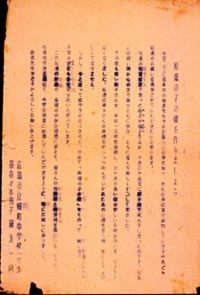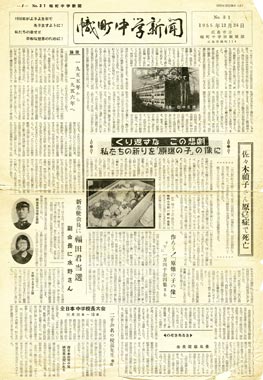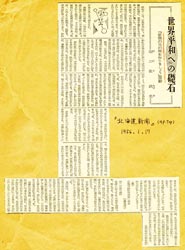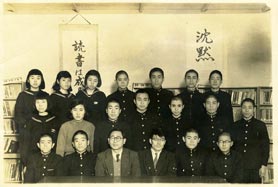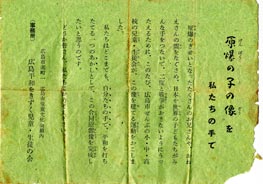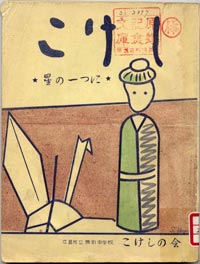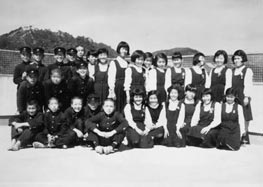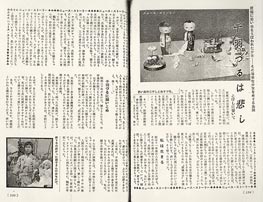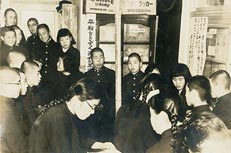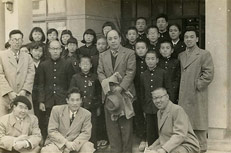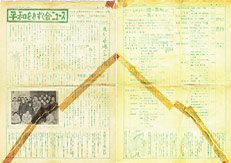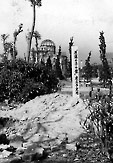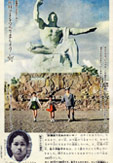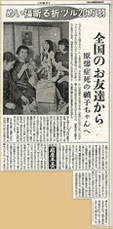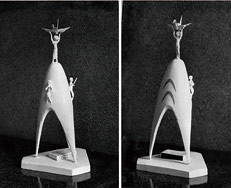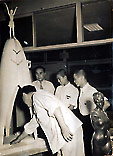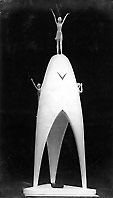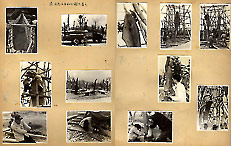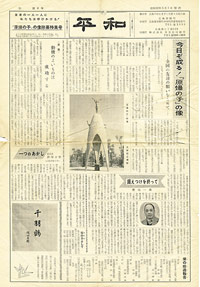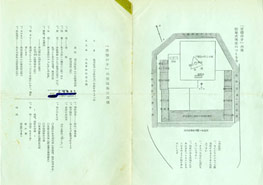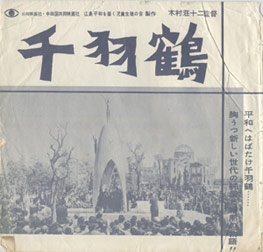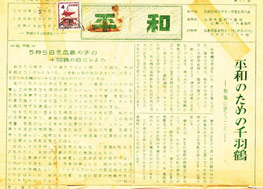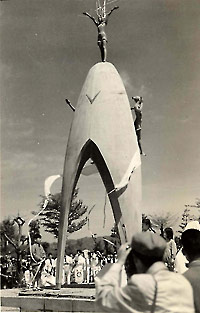Leafletting
Leafletting in front of the venue for the Conference of the National Junior High Schools Principals' Association
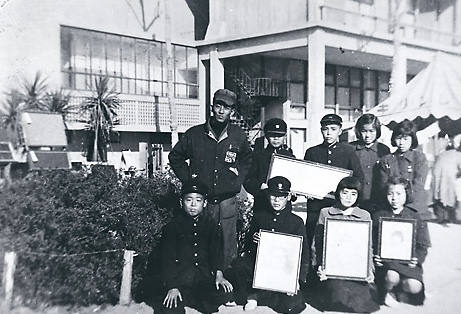
November 12, 1955 / Hiroshima City Auditorium
Courtesy of Tomiko Kawano
The Unity Club, which had proposed the idea of building a statue to console the spirits of Sadako and all the other children who died from the atomic bombing, distributed 2,000 handmade fliers in front of the hall where the Conference of the National Junior High Schools Principals' Association was in progress. The leaflets asked for support for building a monument and stated that the call came from: Hiroshima Municipal Nobori-machi Junior High School 1st Year Students All the classmates of the late Sadako Sasaki.
Click each photo to see a larger image.
Formation of the Hiroshima Society of School Children for Building World Peace
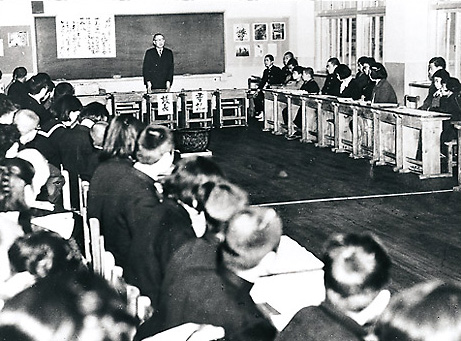
January 18, 1956 /Hiroshima Municipal Nobori-machi Junior High School
Courtesy of Chugoku Shimbun
Contributions from people around Japan who supported the movement flooded into Nobori-machi Junior High School. Amazed at the outpouring of support, the school called on elementary, junior high, and high schools in the city to use the construction of a statue as an opportunity to learn about what happened in the bombing and reflect on peace. In time, the Hiroshima Society of School Children for Building World Peace was organized, comprised by the student councils of each school in the city.
Click each photo to see a larger image.
The Funding Campaign Develops
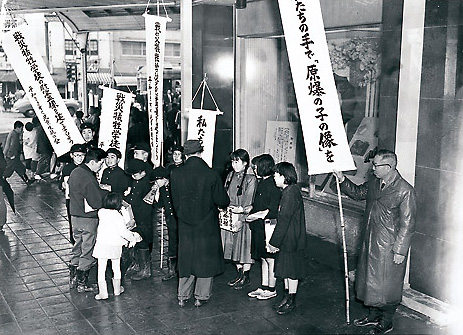
April 8, 1956 / in front of Fukuya Department Store
Courtesy of Chugoku Shimbun
Donated by Seishi Toyota
The members of the Unity Club joined the fundraising campaign centered around the Hiroshima Society of School Children for Building World Peace. On April 1 that year, they issued a prospectus to schools in Japan asking for donations, and the campaign moved into full gear. Because the campaign had already been introduced in newspapers, on the radio, etc., the prospectus quickly garnered responses from schools around the country. About a year after Sadako's death, in October it was decided to erect the statue in Peace Memorial Park. Now it was definite—the statue would be built.
Click each photo to see a larger image.
A large crowd attended Sadako's first death aniversary
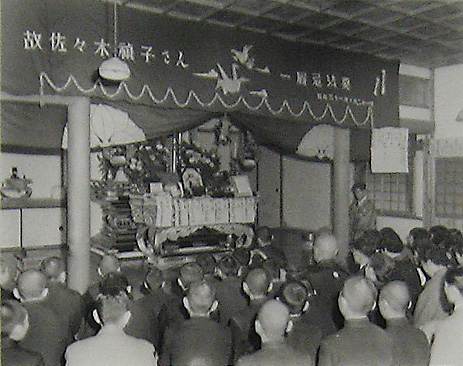
October 21, 1956 / Shinkoji Temple
Courtesy of Chugoku Shimbun
About a year after Sadako’s death, the fundraising was going well.
In October it was decided to erect the statue in Peace Memorial Park.
Now it was definite—the statue would be built.
Once there was nothing left to do but wait for completion, the Hiroshima Society of School Children for Building World Peace began to consider what their next activity might be.
Click each photo to see a larger image.
The Children's Peace Monument
The unveiling ceremony for the Children's Peace Monument
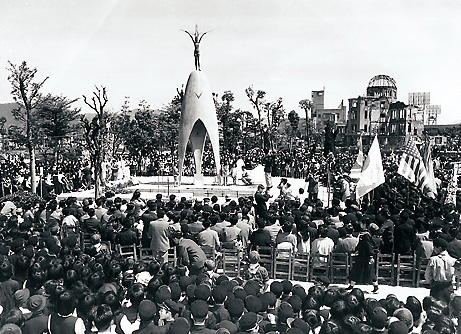
May 5,1958 / Peace Memorial Park
Courtesy of Chugoku Shimbun Company
Girl Holding a Paper Crane
On May 5, 1958, the Children's Peace Monument was unveiled in Peace Memorial Park. Elementary, junior high, and high school students in Hiroshima and around the country were invited, and a total of about 500 people participated, including Sadako's family.
Two and a half year had gone by after the start of the statue movement.
Each with her or his own thoughts and emotions, people gazed at the statue completed through the efforts and goodwill of so many. One of Sadako's classmates-the wellspring of the movement-said that, to her, the statue was Sadako herself.
The Children's Peace Monument stands nine meters tall. The pedestal has three legs, and standing on the top of that pedestal is a "young girl holding a paper crane high over her head." The bronze figures of another girl and a boy decorate the sides of the pedestal. The design of this monument is extremely impressive and became one of the symbolic monuments in Peace Memorial Park.
Click each photo to see a larger image
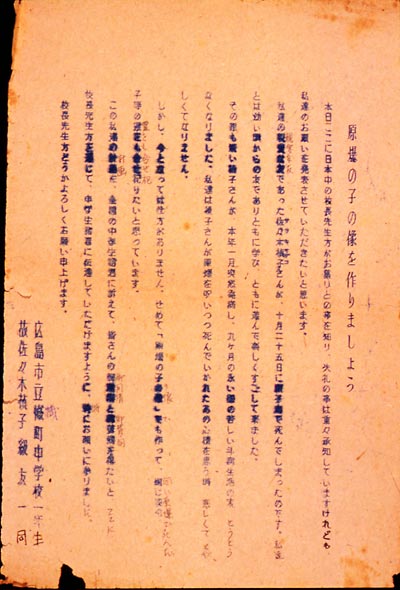
November 12, 1955 / 18
days after Sadako's death
Donated by Kiyoshi Yamamoto
A flier conveying the wish of Sadako's classmates to create a "Children's Peace Monument" was handed to school principals. By the end of the month, funds had quickly started being collected.
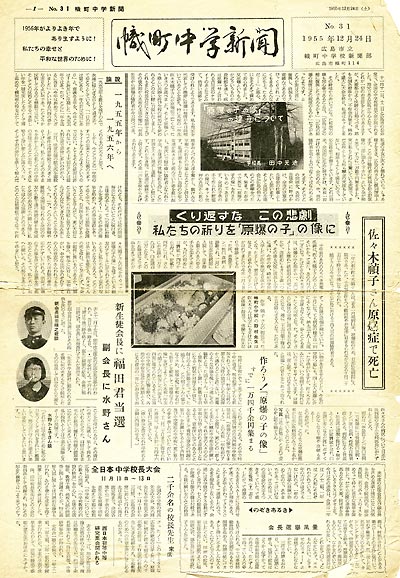
December 24, 1955 / 60
days after Sadako's death
Donated by Seishi Toyota
The newspaper covered Principal Tanaka's call for the building of the monument, and described how the campaign was taking shape. It also introduced the episode describing how Sadako passed away while in the process of folding over a thousand paper cranes.
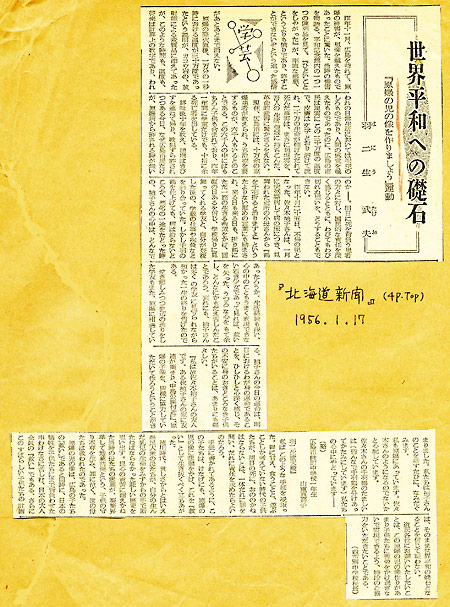
January 17, 1956 / 83 days after Sadako's death
Donated by Seishi Toyota
The principal of Nishi-Ashibetsu Junior High School, Takeo Hanyu, who participated in the Conference of Principals, called for cooperation from Hokkaido in the building of a statue, while referring to a letter from Sadako's classmate Makiko Yamashige.
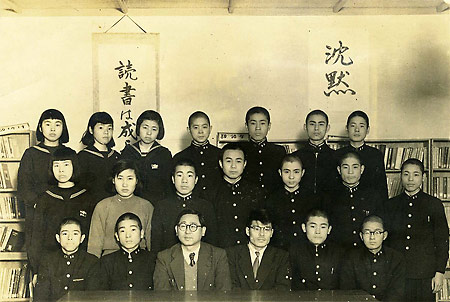
August 5, 1957 / 649 days after Sadako's death
Donated by Seishi Toyota
Nishi-Ashibetsu Junior High School supported the effort as a school, and even sent representatives to the unveiling ceremony.
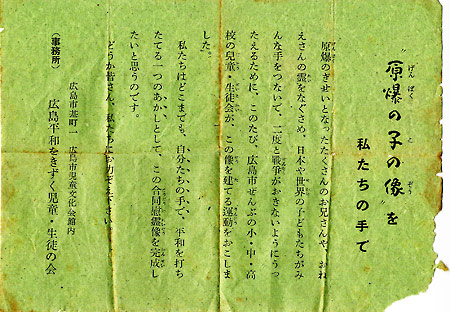
Around 1957
Donated by Shinichi Shine
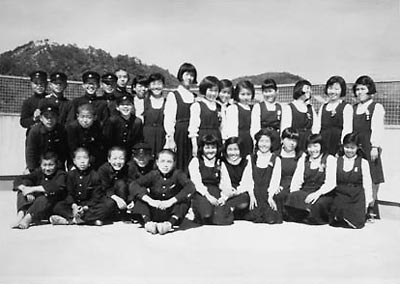
Around 1957
Donated by Seishi Toyota
Photograph taken from the roof of Nobori-machi Junior High School.
"Since the heartfelt wishes of Sadako's classmates developed into the Hiroshima Society of School Children for Building World Peace that we are today, the power of Kokeshi, so to speak, became the driving force through which this Society was created."
From Newsletter No.5 of the Society for Building World Peace
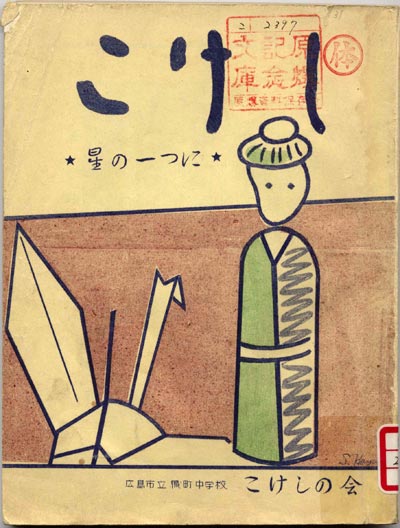
July 25, 1956 / 273 days after Sadako's death
Courtesy of A-bomb Materials Preservation Association
Collection of memorial writings created by Sadako's classmates. The name "Kokeshi," originated from the fact that, when Sadako was hospitalized, her classmates often brought her kokeshi (limbless wooden) dolls, which she loved.
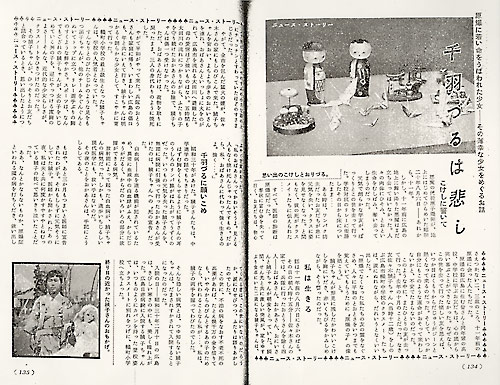
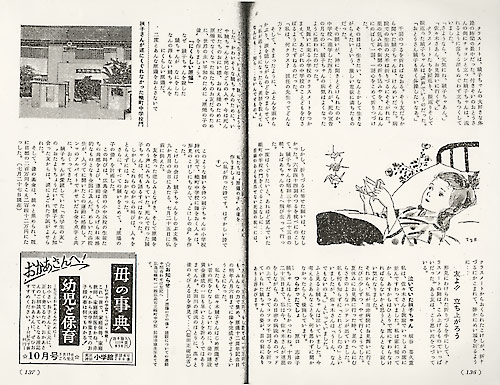
Issued on October 1, 1956 (341 days after Sadako's death)
in "Jyogakusei no Tomo" (A friend of girl students) published by Shogakukan.
Courtesy of Shogakukan, International Institute For Children's Literature, Osaka
One year after Sadako's death, the story of Sadako and One thousand paper cranes was featured in "Jyogakusei no Tomo" a popular girls' magazine at the time. Sadako's letter to find a pen pal had been published ina readers' column of the magazine in 1955.
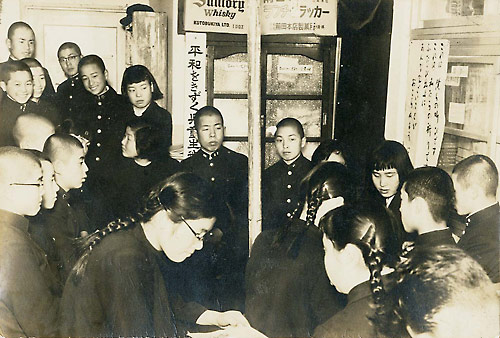
Around 1957
Library of Nobori-machi Junior High School
Donated by Seishi Toyota
The bookshelf to the right displays the inscription that was originally proposed. After debate by the committee on March 1, 1958, the inscription became the text that it is today.
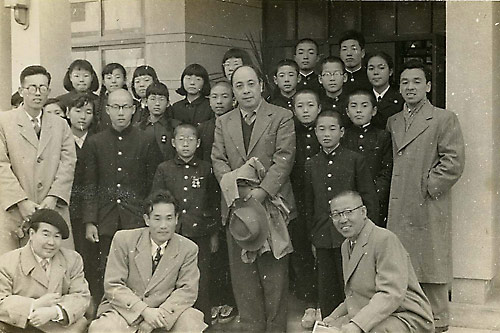
November 28, 1956 / 399 days after Sadako's death
Donated by Seishi Toyota
In October, through Tokyo National Museum director Nagatake Asano, who hailed from Hiroshima, Kazuo Kikuchi, a professor at the Tokyo National University of Fine Arts and Music, was asked to create a monument. Professor Kikuchi (man standing in the center) arrived in Hiroshima on November 28 and developed a plan for making the monument.
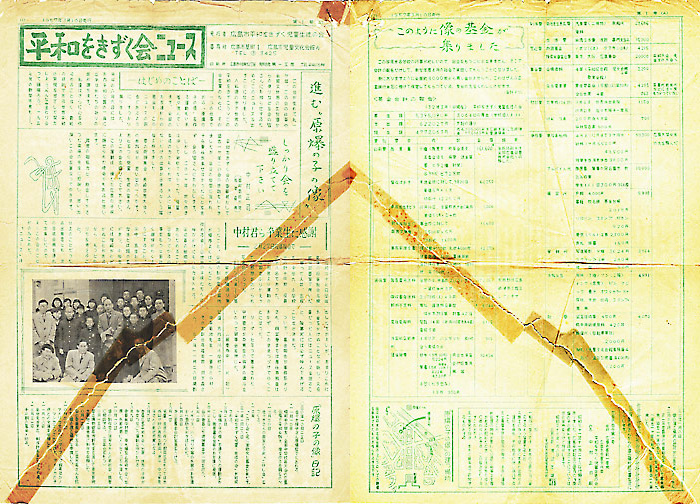
March 10, 1957 / 502 days after Sadako's death
Donated by Seishi Toyota
The monument's building plan was steadily executed, as can be seen here.
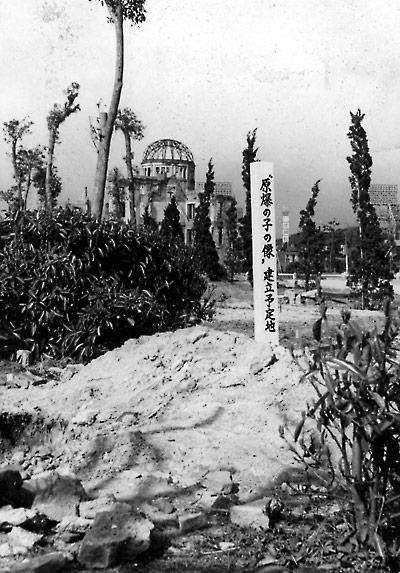
Around 1957 Hiroshima Peace Memorial Park
Donated by Seishi Toyota
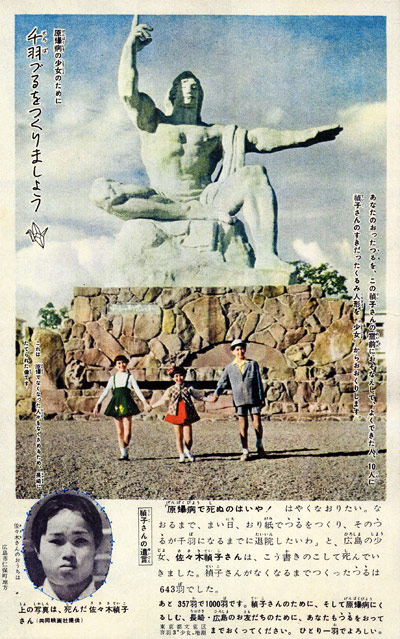
November 1, 1957 / 768 days after Sadako's death
Courtesy of Kobunsha, Kikuyou-Cho Library
The Kobunsha-issued magazine Shojo ("Young Miss"), popular Among girls at that time, introduced readers to Sadako and the building of the monument, and called on readers to "send folded paper cranes for the repose of Sadako's soul."
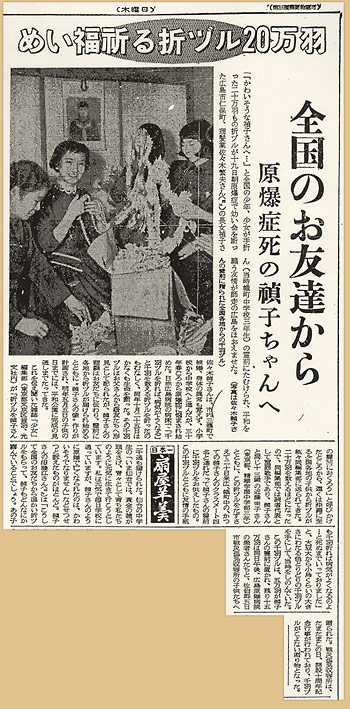
December 19, 1957 / 786 days after Sadako's death
Courtesy of Chugoku Shimbun evening edition
Keiko Kondo, the children's song vocalist known for singing Pan-Uri no Roba-san ("The Donkey Bakery": lyrics by Ryo Yano, music by Minoru Toyoda, King Records, 1955), came to Hiroshima as a reader representative, bringing 200,000 folded paper cranes with her. A description of that scene was introduced in the February-March 1958 issue of the magazine Shojo. As a result, the story of Sadako and the thousands of paper cranes became more widely known.
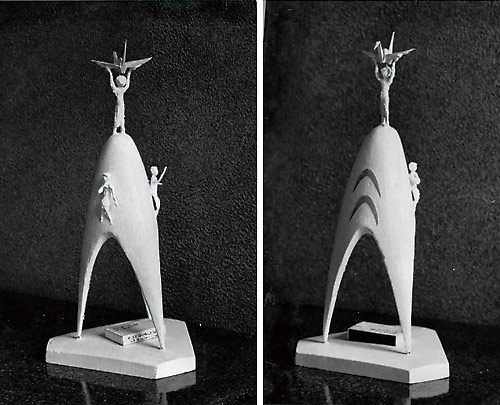
March 10, 1957/ 502 days after Sadako's death
Donated by Seishi Toyota
Professor Kikuchi arrived in Hiroshima with a model about 30 centimeters in size. From the beginning, the monument
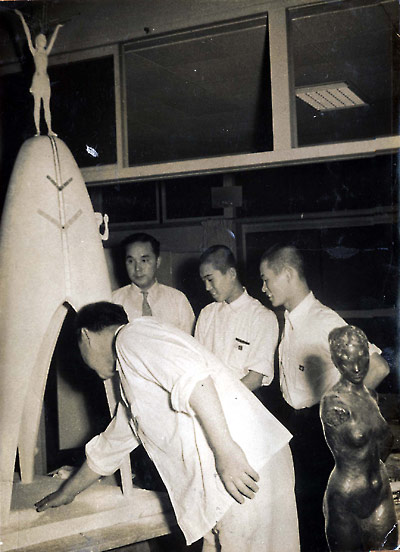
August 14, 1957 / 659 days after Sadako's death
Donated by Seishi Toyota
Society for Building World Peace president Nobuyoshi Tetsumasu and committee member Masahiro Sasaki observed a quarter scale model that Professor Kikuchi was building in his studio.
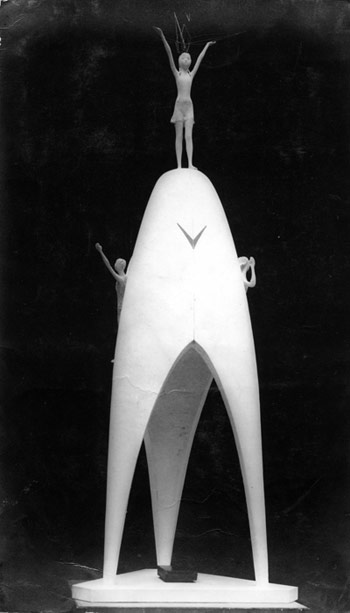
January 15, 1958 / 813 days after Sadako's death
Donated by Seishi Toyota
A bronze monument of the girl was exhibited starting on January 15, 1958 at the "New Creations Hiroshima Venue" held at the Fukuya department store.
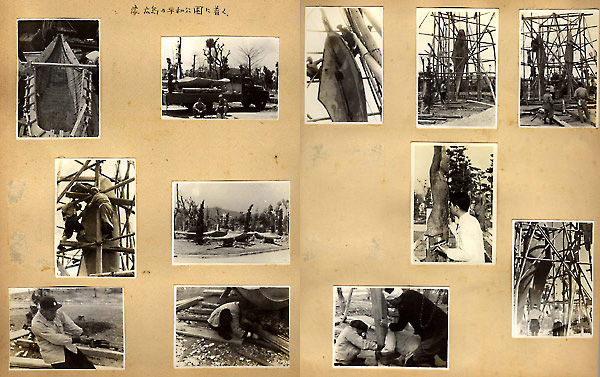
March 23, 1958 / 880 days after Sadako's death
Donated by Seishi Toyota
The monument was set in place on March 23, 1958, and construction began.
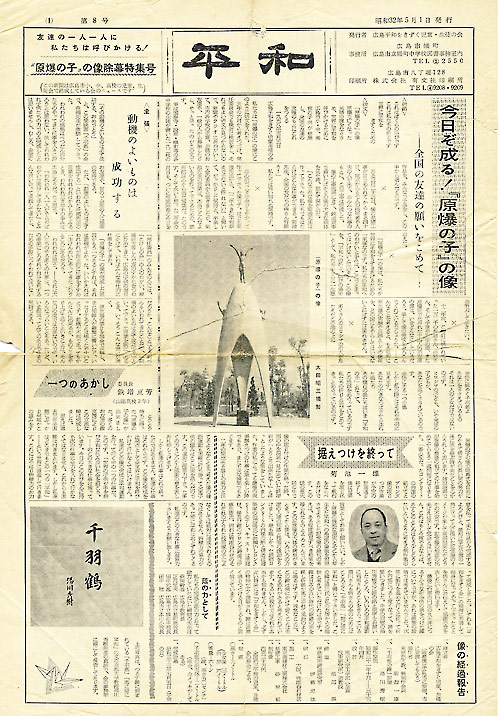
May 1, 1958 / 919 days after Sadako's death
Donated by Seishi Toyota
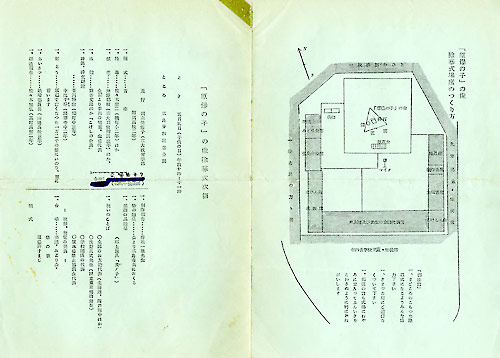
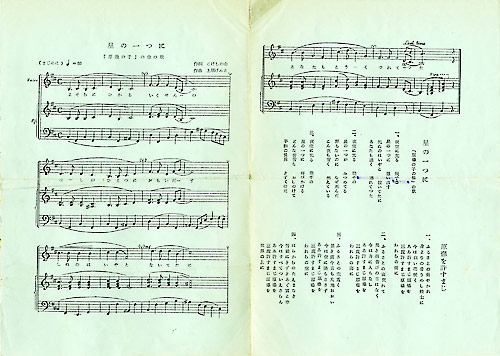
Donated by Kaoru Ogura
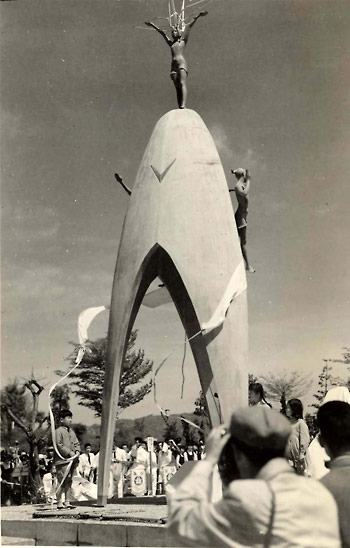
May 5, 1958 / 923 days after Sadako's death
Donated by Ichiro Kawamoto
Sadako's younger brother Eiji Sasaki holds the unveiling netting.
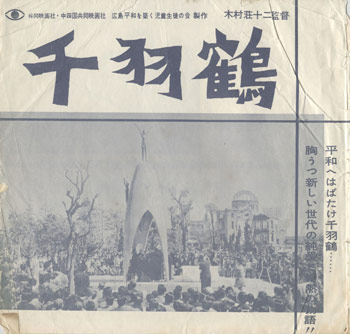
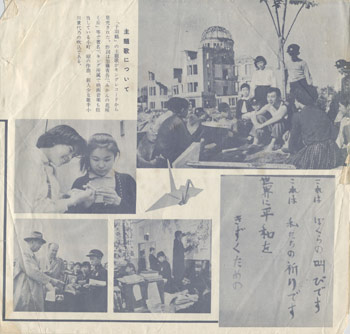
Donated by Seishi Toyota
Along with the building of the monument, the film Thousand PaperCranes" was taken. On June 21, 1958, a preview of the film was shown at the Fukuya department store. In August,a radio drama based on Sadako's life was broadcast by NHK.
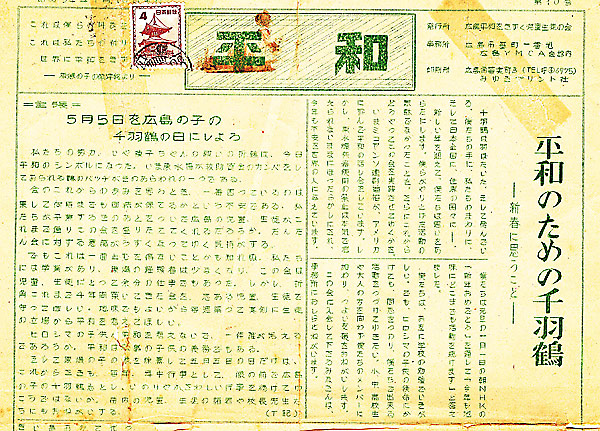
January 10, 1959
Donated by Seishi Toyota


